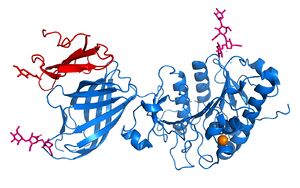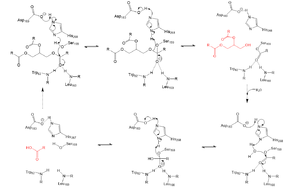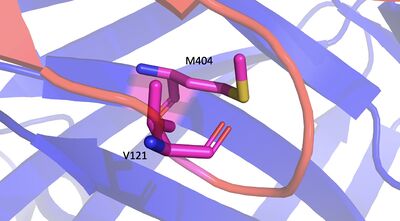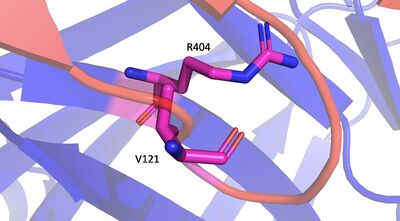User:Maggie Stopa/Sandbox 1
From Proteopedia
(Difference between revisions)
| Line 3: | Line 3: | ||
You may include any references to papers as in: the use of JSmol in Proteopedia <ref>DOI 10.1002/ijch.201300024</ref> or to the article describing Jmol <ref>PMID:21638687</ref> to the rescue. | You may include any references to papers as in: the use of JSmol in Proteopedia <ref>DOI 10.1002/ijch.201300024</ref> or to the article describing Jmol <ref>PMID:21638687</ref> to the rescue. | ||
| - | + | <scene name='87/877513/Catalytic_triad/1'>catalytic triad</scene> | |
==Introduction== | ==Introduction== | ||
A [https://en.wikipedia.org/wiki/Lipase lipase] is an enzyme that is capable of catalyzing the [https://en.wikipedia.org/wiki/Hydrolysis hydrolysis] of fats/lipids which are consumed through oils. It is encoded by the [https://www.genecards.org/cgi-bin/carddisp.pl?gene=LPL p22 region in chromosome 8]. Once synthesized, it is secreted into the interstitial space in several tissues. The main site of action for LPL is in the [https://www.pnas.org/content/pnas/116/5/1480/F1.large.jpg capillary lumen] within muscle and adipose tissue. The function of this lipase is to hydrolyze [https://en.wikipedia.org/wiki/Triglyceride triglycerides] of very low density lipoproteins ([https://qph.fs.quoracdn.net/main-qimg-8e874e647baeb69b00203c47165247e2 VLDL]) and to aid in the delivery of lipid nutrients to vital tissues. The enzyme is commonly found on the surface of cells that line blood capillaries. Two different lipoproteins are essential to break down triglycerides. One of the lipoproteins is utilized to transport fat into the bloodstream from different organs. The lipoproteins essential, in the transport of fat from the intestine are referred to as [https://en.wikipedia.org/wiki/Chylomicron chylomicrons]. VLDL are utilized in carrying triglycerides from the liver into the bloodstream. The hydrolysis of triglycerides by lipoprotein lipase results in fat molecules to be used by the body as energy or stored in fatty tissue. [[Image:LLP11.jpg|300 px|left|thumb|LPL Image]] | A [https://en.wikipedia.org/wiki/Lipase lipase] is an enzyme that is capable of catalyzing the [https://en.wikipedia.org/wiki/Hydrolysis hydrolysis] of fats/lipids which are consumed through oils. It is encoded by the [https://www.genecards.org/cgi-bin/carddisp.pl?gene=LPL p22 region in chromosome 8]. Once synthesized, it is secreted into the interstitial space in several tissues. The main site of action for LPL is in the [https://www.pnas.org/content/pnas/116/5/1480/F1.large.jpg capillary lumen] within muscle and adipose tissue. The function of this lipase is to hydrolyze [https://en.wikipedia.org/wiki/Triglyceride triglycerides] of very low density lipoproteins ([https://qph.fs.quoracdn.net/main-qimg-8e874e647baeb69b00203c47165247e2 VLDL]) and to aid in the delivery of lipid nutrients to vital tissues. The enzyme is commonly found on the surface of cells that line blood capillaries. Two different lipoproteins are essential to break down triglycerides. One of the lipoproteins is utilized to transport fat into the bloodstream from different organs. The lipoproteins essential, in the transport of fat from the intestine are referred to as [https://en.wikipedia.org/wiki/Chylomicron chylomicrons]. VLDL are utilized in carrying triglycerides from the liver into the bloodstream. The hydrolysis of triglycerides by lipoprotein lipase results in fat molecules to be used by the body as energy or stored in fatty tissue. [[Image:LLP11.jpg|300 px|left|thumb|LPL Image]] | ||
| - | + | <scene name='87/877513/Catalytic_triad/3'>catalytic triad</scene> | |
==Structural Overview== | ==Structural Overview== | ||
Lipoprotein Lipase is assumed to only be active as a <scene name='87/877513/Lpl_dimer/1'>homodimer</scene>, however, previous studies have argued that the lipase can be active in its monomeric form. (https://www.ncbi.nlm.nih.gov/pmc/articles/PMC6442593/) The N-terminal domain of lipoprotein lipase is known to consist of an alpha/beta hydrolase domain, which is composed of six alpha helices and ten beta-strands. This domain creates an <scene name='87/877513/Secondary_structure/1'>alpha/beta hydrolase fold</scene>. The C-terminal domain of lipoprotein lipase is composed of twelve beta strands which form a “<scene name='87/877513/Secondary_structure/1'>barrel domain | Lipoprotein Lipase is assumed to only be active as a <scene name='87/877513/Lpl_dimer/1'>homodimer</scene>, however, previous studies have argued that the lipase can be active in its monomeric form. (https://www.ncbi.nlm.nih.gov/pmc/articles/PMC6442593/) The N-terminal domain of lipoprotein lipase is known to consist of an alpha/beta hydrolase domain, which is composed of six alpha helices and ten beta-strands. This domain creates an <scene name='87/877513/Secondary_structure/1'>alpha/beta hydrolase fold</scene>. The C-terminal domain of lipoprotein lipase is composed of twelve beta strands which form a “<scene name='87/877513/Secondary_structure/1'>barrel domain | ||
Revision as of 19:39, 19 April 2021
Lipoprotein Lipase LPL
| |||||||||||




